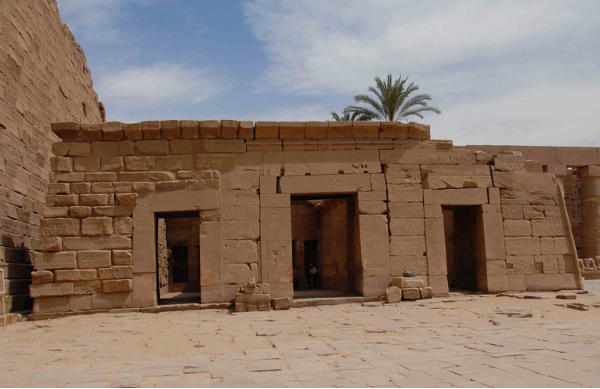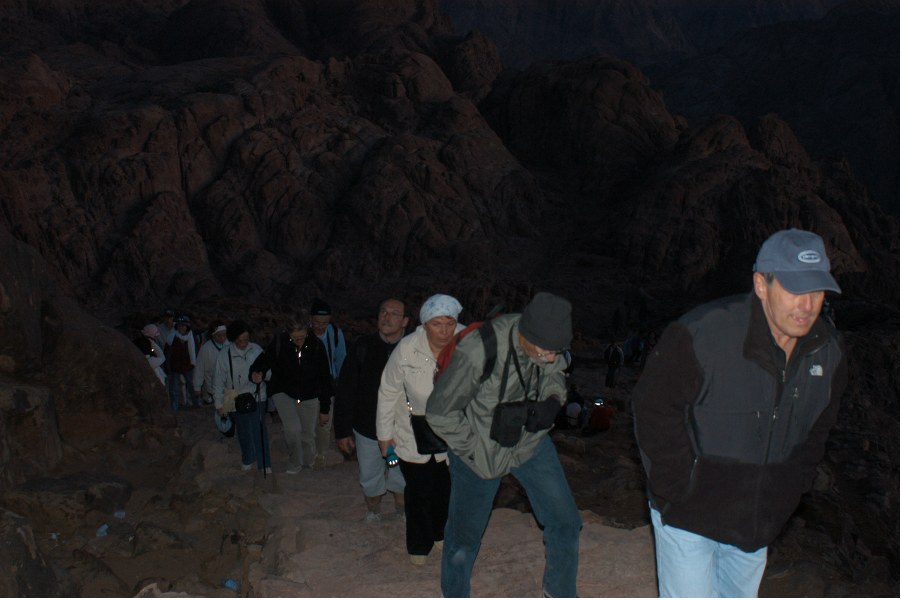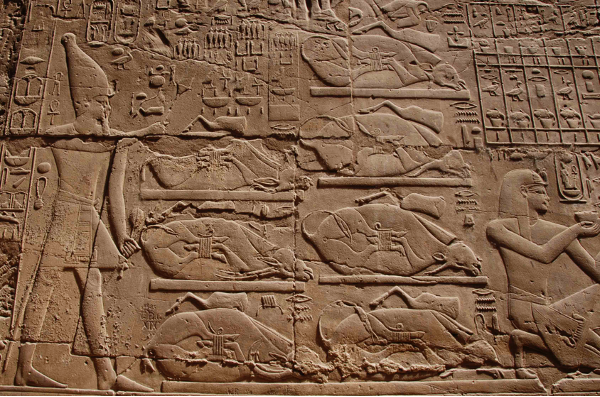Egyptian Myth Busters, Part 2
Myth: Camels are ugly and they stink.
Truth: Camels are actually drop-dead handsome and sweet-smelling . . . like me!
(Listen to an audio version of the blog post above!)
Myth #5: The Israelites worshipped a golden calf in the wilderness.
At the time of Moses, Egypt was a highly advanced civilization, and its theology was as fully developed as Judaism or Christianity is today. Memphis, in the northern part of Egypt, was the political capital of Egypt, while Thebes to the south (modern-day Luxor) was the religious capital. Thebes was the home of magnificent temples dedicated to the Egyptian gods, along with more than 8,000 priests to serve them. One of the best examples of an Egyptian temple is the Temple of Karnak.
Professor Emad Faltas, our Logos colleague and Egyptologist,
teaches on the “Avenue of the Sphinxes” in front of Karnak Temple.
Notice the two huge pylons that serve as an entryway to the temple. All Egyptian temples consisted of five elements: 1) entryway pylons, 2) courtyard, 3) garden, 4) vestibule, and 5) holy of holies. The five elements anticipate the design of Israel’s tabernacle: 1) the entryway, 2) the courtyard, 3) the altar/laver, 4) the holy place (with the menorah, altar of incense and table of showbread), and 5) the holy of holies (with the ark of the covenant). Only priests were permitted inside Karnak Temple, a practice adopted by the Israelites with the tabernacle, and later with the temple in Jerusalem.
Karnak Temple at night.
Three images sit in the temple courtyard of Karnak Temple, one for each god of the
Triad of Thebes, to whom the temple is dedicated: 1) Amon, the father god;
2) Mut, the mother god; and 3) Khonse, the son god.
Professor Faltas teaches inside the holy of holies. A golden image of Amon would have sat on the stone platform in the foreground, as the ark of the covenant sat in the holy of holies in the tabernacle.
The Temple of Karnak flourished during the period that the Israelites were in Egypt, and it represented the fully developed and sophisticated religion that the Israelites experienced during their nearly half a millennium in Egypt. Indeed, the Egyptian gods must have seemed very real and quite powerful to the Israelites.
When God brings the Israelites out of Egypt in the Exodus, he moves them to Mt. Sinai in the southern portion of the Sinai peninsula, a vast, barren, remote and dangerous land. Moses then climbs Mt. Sinai, the mountain of God, and he disappears into a huge display of smoke and fire. Then in Exodus 32: 1 we read: “When the people saw that Moses was so long in coming down from the mountain [over a month!] they gathered around Aaron and said, ‘Come, make us gods [literally “a god”] who will go before us. As for this fellow Moses who brought us up out of Egypt, we don’t know what has happened to him.’”
Mount Sinai (7,497 feet), Sinai Peninsula, Egypt.
Dr. C. leads his Logos students up Mount Sinai in the dark of night!
Clearly, the Israelites view themselves as being in big trouble: they have left a devastated Egypt behind them; they are responsible for wiping out the entire Egyptian army in the Red Sea; they have lost Moses, their leader; they are in the middle of what Moses calls a “vast and dreadful wilderness” (Deuteronomy 1: 19); and God, who brought them out of Egypt, has apparently abandoned them. They believe they are all going to die in a barren and frightening place. The Israelites need a strong god to get them out of this mess! So they turn to one of the strongest gods in the Egyptian pantheon, a god they know intimately from their four hundred year stay in Egypt: Hathor.
Hathor had been worshipped since the Old Kingdom, 2686-2181 B.C., long before Abraham, the Israelites or Moses arrived in Egypt. The daughter of Ra, the sun god, and the wife of Horus, Hathor appears in three iconographic forms: 1) as a woman, 2) as a cow, and 3) as a lion. As a woman she is often referred to as “the golden one;” “she of the beautiful hair;” or “the lady of drunkenness,” representing the joyful intoxication involved in her worship (hence, the drunken revelry Moses sees when he descends the mountain—Exodus 32: 17-19); the Greeks associated her with the goddess of love, Aphrodite. As a cow, Hathor represents motherhood, and she is often presented as the divine mother of the ruling king. In a statue at her temple in Deir al-Bahri, Luxor, she is portrayed as a cow suckling Amonhotep II, who in our dating scheme is the Pharaoh of the Exodus. As a lion, Hathor is a warrior goddess, protecting her children. Most often, her iconography is a woman wearing the headdress of a sun disk and a cow’s horns.
Here we see Ptolomy IV presenting himself to Hathor (center) and her sister, Isis (left) at Philae Temple.
When the Israelites say, “Come, make us [a god] who will go before us. As for this fellow Moses who brought us up out of Egypt, we don’t know what has happened to him,” Aaron crafts a golden calf for them, an image of Hathor. In desperation the Israelites call upon Hathor, daughter of the great sun-god, Ra, to rescue them. The golden calf is simply the iconographic image of Hathor, a symbolic representation of her motherhood and her role as nurturer and protector of her children, much as Christians might face a crucifix to pray.
Myth #6: God introduced circumcision in Genesis 17 when he gave it to Abraham as a badge of the covenant.
The Egyptians practiced circumcision as early as the Old Kingdom period, 2686-2181 B.C., before Abraham ever came to Egypt, and images of circumcised men are common in Egyptian art. Here, for example, is a 5th dynasty image on painted limestone from the mastaba of Kaemrehu in Saqqara, Egypt. Kaemrehu was a high priest of the pyramid of King Niuserre at Abu-Sir, roughly 300 years before Abraham arrived in Egypt.
Image of circumcised youth from the mastaba of Kaemrehu, Saqqara, Egypt, c. 2300 B.C.
Myth #7: God introduced animal sacrifice when he prescribed the five great sacrifices in Leviticus 1-6.
The world at the time of Abraham, Isaac, Jacob and Moses was polytheistic. Every culture at this period believed in many gods; indeed, the very idea of only one god would have been absurd to a person living at this time. When God tells Abraham, Isaac and Jacob that he is to be their god, he is not claiming to be the only god; rather, he claims be their only god. The idea of only one god doesn’t emerge until around the time of Isaiah the prophet in the eighth century B.C. By the time of the New Testament, the idea is firmly in place among the Israelites, although not among the surrounding cultures.
How one worships the gods takes on a common form throughout the ancient world. Priests serve as intermediaries between the people and the gods, and they function in temples dedicated to the gods. In the temple, priests present food and drink offerings to honor the gods. The food offering is either grain or animal sacrifices, and the drink offering is wine. The offerings, of course, should be the very best available; hence, the animal sacrifice would be the best of the herd or flock, the grain offering would be the first fruits of the crop, and the drink offering would be the best wine. In some cultures, the best that one had to offer would be a son or a daughter, introducing the practice of human sacrifice (recall God stopping Abraham from sacrificing his son Isaac in Genesis 22)—but few cultures actually practiced human sacrifice, and when they did in was aberrant. If we stick to our dating scheme, the Exodus takes place in 1446 B.C., and God prescribes the five great sacrifices of Leviticus 1-6 in 1445 B.C. They consist of: 1) the burnt offering, 2) the grain offering, 3) the peace offering, 4) the sin offering, and 5) the guilt offering. Four of the five offerings are animal sacrifices.
Here we have a portrayal of bulls being prepared for sacrifice at Karnak Temple in Luxor, which was built under the leadership of King Montuhotep II (2055-2004 B.C.) and which flourished during the New Kingdom (1567-1085 B.C.), the very period of Moses and the Exodus.
A priest preparing bulls for sacrifice at Karnak Temple, Luxor.
Myth #8: The pharaoh of the Exodus was drowned in the Egyptian Red Sea when the parted waters engulfed the pursuing Egyptian army.
If we date the Exodus at 1446 B.C., then Amonhotep II (1450-1425 B.C.) is the pharaoh of the Exodus; if we place the Exodus in the 1200s B.C., then it is Ramses II (1279-1213 B.C.). When the Egyptian army pursues the Israelites into the Red Sea, we read that the Lord said to Moses. “Stretch out your hand over the sea so that the waters may flow back over the Egyptians and their chariots and horsemen.” Moses stretched out his hand over the sea, and at daybreak the sea went back to its place. The Egyptians were fleeing toward it, and the Lord swept them into the sea. The water flowed back and covered the chariots and horsemen—the entire army of Pharaoh that had followed the Israelites into the sea. Not one of them survived (Exodus 14: 26-28). Notice that it is Pharaoh’s army that is drowned in the sea, not Pharaoh himself.
The tomb of Amonhotep II was discovered by Victor Loret on the slope opposite the Valley of the King’s main wadi in March of 1898. It is designated KV 35. A large tomb with a complex architectural structure, it had long since been looted.
Entrance to the Valley of the Kings, Egypt.
Diagram of KV 35, tomb of Amonhotep II
The tomb of Ramses II is one of the largest tombs in the Valley of the Kings, it measures more than 820 square meters, and is designated KV 7. Unfortunately, Ramses II built it at the foot of the northern side of the main valley in a very poor location. Over the centuries it has seen no less than seven major flooding events, and the once magnificent paintings on the walls have mostly flaked off; even the underlying shale has been subjected to moisture-induced swelling. Although most of the debris has been cleared from the tomb, it is not open to visitors due to its instability and poor condition.
The mummies of both Amonhotep II and Ramses II have been preserved and they are on display, along with twenty other royal mummies from the 17th through 20th dynasties, in the new Royal Mummies’ Hall at the National Museum of Egyptian Civilization (NMEC) in Cairo, Egypt. We will visit Ramses II during our 2022 “Footsteps of the Patriarchs” teaching tour.
The Mummy of Ramses II, Egypt’s most famous Pharaoh.
The Ramses II mummy has a particularly interesting story. As we noted, it was buried in KV 7 when Ramses died, but it was later moved to the mummy cache at Deir el-Bahri, where it was found in 1881. In 1885 it was placed in the old British-built Egyptian Museum in Cairo. In 1974, Egyptologists noticed that after more than 3,000 years the mummy was rapidly deteriorating. They decided to fly it Paris for examination. Ramses II was issued an Egyptian passport, and his occupation was listed as “King (deceased)!” In Paris the mummy was diagnosed and treated for a fungal infection, and Ramses II was then returned, healthy and in pristine condition, to Egypt.













